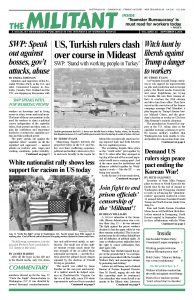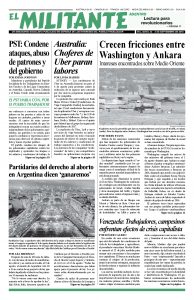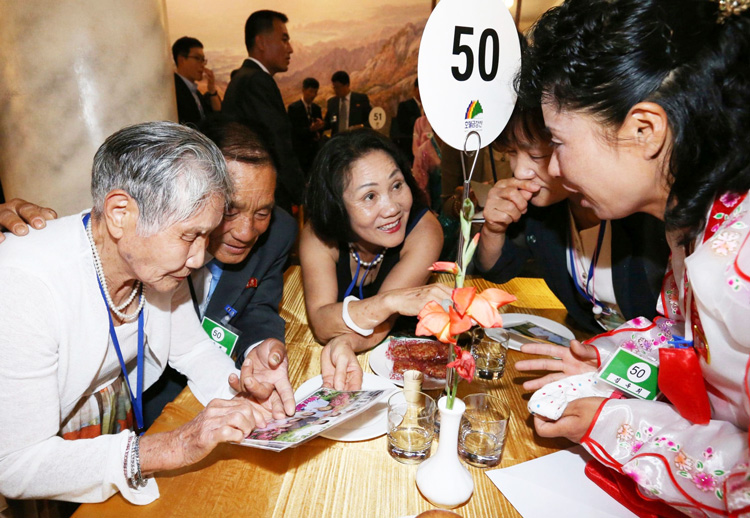Secretary of State Mike Pompeo plans to return to North Korea for the fourth time by the end of August as Washington and Pyongyang continue to work on advancing the “denuclearization” agreement reached at a June 12 summit between President Donald Trump and North Korean leader Kim Jong Un.
Kim and South Korean President Moon Jae-in will hold their third face-to-face summit in Pyongyang, North Korea’s capital, in September. Moon, in close collaboration with the White House, also signed a denuclearization agreement with Kim in April.
The North Korean government is pushing for Washington to speed up the process by signing a peace treaty formally ending the 1950-53 Korean War. In the first ever military defeat for U.S. imperialism, Korean workers and peasants, aided by Chinese volunteers, pushed U.S-forces back to the 38th parallel and fought them to a stalemate. Washington agreed to an armistice but has refused to sign a peace treaty.
Washington’s hostility to North Korea has made the border between North and South one of the most tense in the world, and continued the longest national division that grew out of the second imperialist world war. Some 70 percent of North Korea’s 1.2 million soldiers are deployed within 60 miles of the Demilitarized Zone. The South Korean armed forces, though smaller, are backed by 28,500 U.S. troops, U.S. artillery, 2,000 U.S.-supplied tanks, and hundreds of fighter jets and bombers, including nuclear-capable ones.
In recent years, Pyongyang has developed and tested both nuclear weapons and intercontinental missiles capable of reaching U.S. soil.
“It’s in the interest of workers and farmers across the globe for the U.S. government to sign a peace treaty and end all sanctions on the North,” Róger Calero, Socialist Workers Party candidate for governor of New York, said Aug. 21. “Lessening the tension opens space for working people to discuss together and fight for their class interests.
“Washington and Moscow divided Korea against the will of the Korean people. U.S. troops imposed the bloody dictatorship of Syngman Rhee on the South,” Calero said. “In the North, working people ended the rule of the capitalist class and landlords. It’s U.S. imperialism’s violation of Korean sovereignty that caused the war. We demand the U.S. get its troops and weaponry out of Korea,” Calero said. “Korea is one!”
Talks continue
“North Korea has retreated a little from its original refusal to move forward on denuclearization without an end-of-war declaration,” South Korean daily Hankyoreh wrote in an editorial Aug. 17, “while the U.S. has reportedly stopped insisting that the North must disclose a list of nuclear facilities before anything else can happen.”
Pyongyang hasn’t tested ballistic missiles or nuclear weapons since last year, has destroyed several nuclear facilities and recently returned the remains of over 50 U.S. soldiers missing since the war. Plans are underway for a U.S. team to join in the search for more remains.
Washington has suspended the massive U.S.-South Korean “war games” that Trump admits were a provocation. At the same time, Washington continues to tighten economic and financial sanctions that have deepened hardships for working people in the North, saying they want faster, more far-reaching movement from North Korean leaders.
South Korean President Moon announced steps Aug. 15 to promote the modernizing of rail links and roads with North Korea. Moon said he would like the groundbreaking ceremonies to take place before the end of the year.
The modernization of North Korea’s rail system — making it possible to double speeds from 30 mph to 60 mph — would open the door to more exports not only to the North, but also from South Korea through Russia to Western Europe. South Korea’s Hyundai Glovis started a test run on the Russian leg Aug. 14. Cargo was loaded on a ship from Busan port to Vladivostok, then loaded on a block train to St. Petersburg, cutting the previous 43-day trip by sea through the Suez Canal in half.
Business Insider reported that the rail lines would ultimately connect “Russia’s Trans-Siberian Railroad, South Korea’s two largest cities (Seoul and Busan), North Korea’s third largest city (Chongjin) and its industrial zone with the highest GDP per capita (Rajin).”
The project would require billions of dollars of funding from capitalist investors in the U.S., Russia, South Korea and China. While these capitalists do so in search of big profits, what is important for working people is these moves would break through the isolation that has been imposed on North Korean workers by U.S. imperialism for decades.
“Since late June Mr. Kim has devoted almost all his public activities to visiting factories, farms and construction sites, rather than the military units and weapons test sites that he frequented last year,” the New York Times wrote Aug. 20.
North-South family reunions
For the first time since 2015, 89 South Koreans went to Mount Kumgang resort Aug. 20, just north of the DMZ, to meet family members in the North they had not seen since the war. More than 56,000 South Koreans have registered for future reunions.
Kim Byung-oh, 88, was one of the lucky ones from the South to be selected for the three-day get-together. He met his sister, 81-year-old Kim Soon Ok. “Oh brother, it will be great when reunification happens,” she told him. “Let reunification happen, and let’s live together for even just one minute before we die.”
For now, with no phone communication or mail delivery between North and South, there is no way to stay in touch. The next reunion is set for Aug. 24- 26.
Continuing moves toward ending the economic squeeze on North Korea, lessening military tensions in Korea, Japan and throughout the region and opening the door to reunification of the country are good for the working class.


